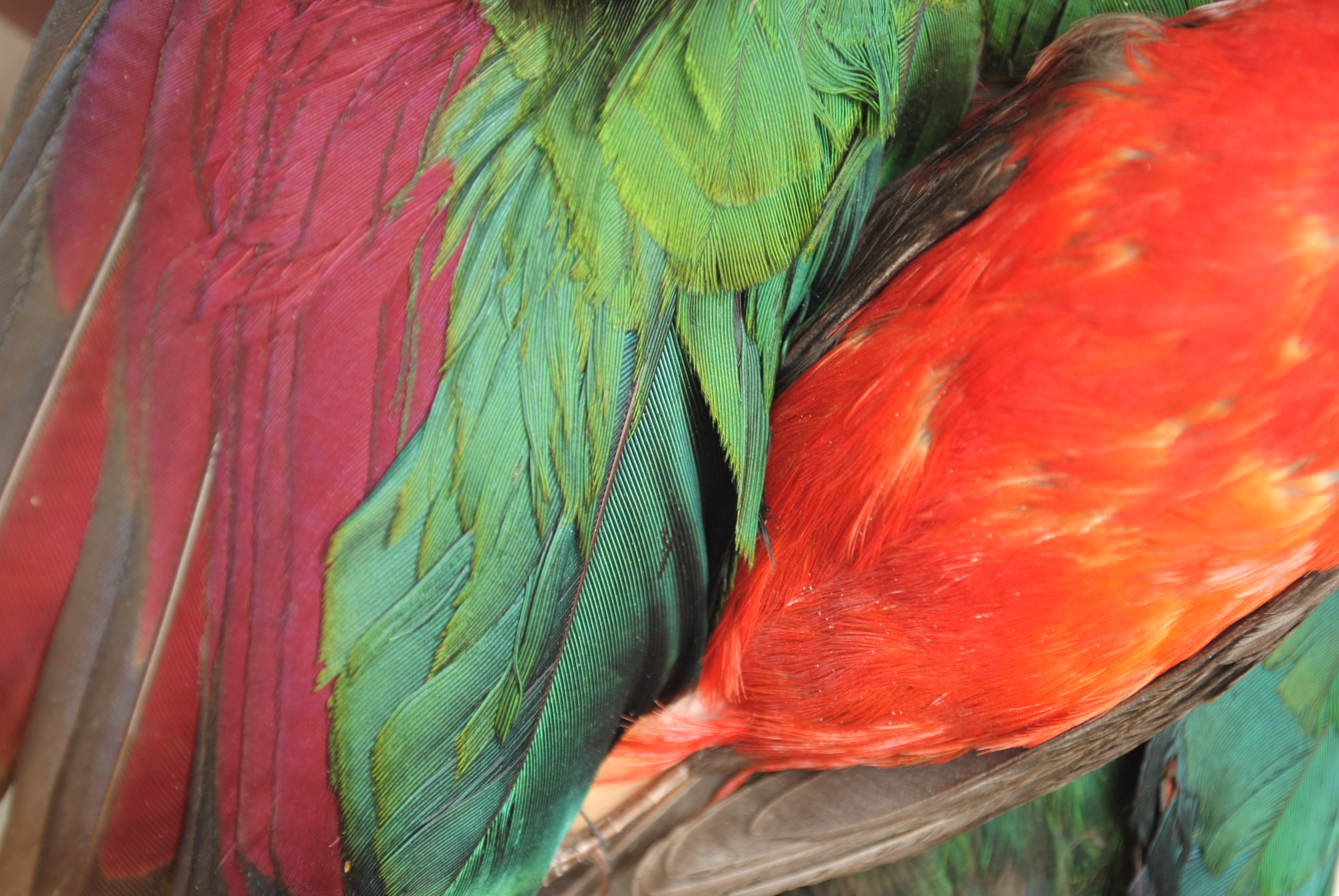|
Turacoverdin
Turacoverdin is a unique copper uroporphyrin pigment responsible for the bright green coloration of several birds of the family Musophagidae, most notably the turaco. It is chemically related to turacin, a red pigment also found almost exclusively in turacos. Turacoverdin is one of the only true green pigments found in birds, as the coloration that appears in most green feathers is due to the unique properties of blue structural coloration in combination with yellow carotenoids. Turacoverdin and turacin were the first ever chemically characterized feather pigments, and turacoverdin was first isolated and described in 1882 by Dr. C.F.W. Krukenberg. Chemical properties Few studies into the chemical nature of turacoverdin have been performed to date. Research by R.E. Moreau in the 1950s showed it to be less soluble in basic solutions than its chemical cousin turacin. While originally thought to contain little copper by its discoverer, who instead believed it to be iron-based, later ... [...More Info...] [...Related Items...] OR: [Wikipedia] [Google] [Baidu] |
Turaco
The turacos make up the bird family Musophagidae ( "banana-eaters"), which includes plantain-eaters and go-away-birds. In southern Africa both turacos and go-away-birds are commonly known as loeries. They are semi-zygodactylous: the fourth (outer) toe can be switched back and forth. The second and third toes, which always point forward, are conjoined in some species. Musophagids often have prominent crests and long tails; the turacos are noted for peculiar and unique pigments giving them their bright green and red feathers. Traditionally, this group has been allied with the cuckoos in the order Cuculiformes, but the Sibley-Ahlquist taxonomy raises this group to a full order Musophagiformes. They have been proposed to link the hoatzin to the other living birds, but this was later disputed. Recent genetic analyses have strongly supported the order ranking of Musophagiformes. Musophagidae is one of very few bird families endemic to Africa, one other being the mousebirds, ... [...More Info...] [...Related Items...] OR: [Wikipedia] [Google] [Baidu] |
Feather
Feathers are epidermal growths that form a distinctive outer covering, or plumage, on both avian (bird) and some non-avian dinosaurs and other archosaurs. They are the most complex integumentary structures found in vertebrates and a premier example of a complex evolutionary novelty. They are among the characteristics that distinguish the extant birds from other living groups. Although feathers cover most of the bird's body, they arise only from certain well-defined tracts on the skin. They aid in flight, thermal insulation, and waterproofing. In addition, coloration helps in communication and protection. Plumology (or plumage science) is the name for the science that is associated with the study of feathers. Feathers have a number of utilitarian, cultural, and religious uses. Feathers are both soft and excellent at trapping heat; thus, they are sometimes used in high-class bedding, especially pillows, blankets, and mattresses. They are also used as filling for winter cloth ... [...More Info...] [...Related Items...] OR: [Wikipedia] [Google] [Baidu] |
Tauraco Persa32
''Tauraco'' is a genus of turacos. It contains the "typical" or green turacos; though their plumage is not always green all over, the presence of significant amounts of turacoverdin-colored plumage generally sets ''Tauraco'' species apart from other Musophagidae. Indeed, as opposed to any other known birds, ''Tauraco'' turacos are the only living bird taxa that have any significant green pigment whatsoever, as the greens of many parrots etc. are due to structural color, not pigment. Their genus name was derived from a native West African name. Taxonomy The genus ''Tauraco'' was introduced in 1779 by the Polish naturalist Jan Krzysztof Kluk Jan Krzysztof Kluk (September 13, 1739 – July 2, 1796) was a Polish naturalist agronomist and entomologist. He was the son of Jan Krzysztof Adrian and Marianna Elżbieta. His father, an impoverished nobleman, was a building contractor and .... The type species was later designated as the Guinea turaco. Species The genus c ... [...More Info...] [...Related Items...] OR: [Wikipedia] [Google] [Baidu] |
Tauraco
''Tauraco'' is a genus of turacos. It contains the "typical" or green turacos; though their plumage is not always green all over, the presence of significant amounts of turacoverdin-colored plumage generally sets ''Tauraco'' species apart from other Musophagidae. Indeed, as opposed to any other known birds, ''Tauraco'' turacos are the only living bird taxa that have any significant green pigment whatsoever, as the greens of many parrots etc. are due to structural color, not pigment. Their genus name was derived from a native Niger–Congo languages, West African name. Taxonomy The genus ''Tauraco'' was introduced in 1779 by the Polish naturalist Jan Krzysztof Kluk. The type species was later designated as the Guinea turaco. Species The genus contains 13 species. References External links * * {{Taxonbar, from=Q654783 Tauraco, Bird genera ... [...More Info...] [...Related Items...] OR: [Wikipedia] [Google] [Baidu] |
Knysna Turaco
The Knysna turaco (''Tauraco corythaix''), or, in South Africa, Knysna loerie, is a large turaco, one of a group of African musophagidae birds. It is a resident breeder in the mature evergreen forests of southern and eastern South Africa, and Swaziland. It was formerly sometimes considered to be a subspecies of the green turaco of West Africa. The Livingstone's and Schalow's turacos were once considered subspecies. This species lays two eggs in a shallow platform nest made from sticks and placed in a tree or clump of creepers. Within its range, this is an unmistakable bird, although often inconspicuous in the treetops. It is 40–42 cm long, including a long tail. The small but thick orange-red bill and a white line just under the eye contrast with the mainly green plumage. It has a tall green crest, which is tipped with white. The eye is brown and the eye-ring deep red. In flight, Knysna turaco shows conspicuous crimson primary flight feathers. Sexes are similar, but juven ... [...More Info...] [...Related Items...] OR: [Wikipedia] [Google] [Baidu] |
Turacin
Turacin is a naturally occurring red pigment that is 6% copper complexed to uroporphyrin III. Arthur Herbert Church discovered turacin in 1869. It is found only in the bird family Musophagidae, the turacos. Other birds derive their red coloration from carotenoids (bright and orange-reds) or phaeomelanins (rusty and brownish-reds). It is often assumed that this coloration will wash out when the birds are bathing or after heavy rains, but this is true only if the water used for bathing happens to be very alkaline. See also * Psittacofulvin, a brightly colored red and yellow pigment unique to parrots * Turacoverdin Turacoverdin is a unique copper uroporphyrin pigment responsible for the bright green coloration of several birds of the family Musophagidae, most notably the turaco. It is chemically related to turacin, a red pigment also found almost exclusively ..., green pigment unique to turacos References Biological pigments {{ornithology-stub ... [...More Info...] [...Related Items...] OR: [Wikipedia] [Google] [Baidu] |
Plumage
Plumage ( "feather") is a layer of feathers that covers a bird and the pattern, colour, and arrangement of those feathers. The pattern and colours of plumage differ between species and subspecies and may vary with age classes. Within species, there can be different colour morphs. The placement of feathers on a bird is not haphazard, but rather emerge in organized, overlapping rows and groups, and these are known by standardized names. Most birds moult twice a year, resulting in a breeding or ''nuptial plumage'' and a ''basic plumage''. Many ducks and some other species such as the red junglefowl have males wearing a bright nuptial plumage while breeding and a drab ''eclipse plumage'' for some months afterward. The painted bunting's juveniles have two inserted moults in their first autumn, each yielding plumage like an adult female. The first starts a few days after fledging replacing the ''juvenile plumage'' with an ''auxiliary formative plumage''; the second a month or so l ... [...More Info...] [...Related Items...] OR: [Wikipedia] [Google] [Baidu] |
Ultraviolet–visible Spectroscopy
UV spectroscopy or UV–visible spectrophotometry (UV–Vis or UV/Vis) refers to absorption spectroscopy or reflectance spectroscopy in part of the ultraviolet and the full, adjacent visible regions of the electromagnetic spectrum. Being relatively inexpensive and easily implemented, this methodology is widely used in diverse applied and fundamental applications. The only requirement is that the sample absorb in the UV-Vis region, i.e. be a chromophore. Absorption spectroscopy is complementary to fluorescence spectroscopy. Parameters of interest, besides the wavelength of measurement, are absorbance (A) or transmittance (%T) or reflectance (%R), and its change with time. Optical transitions Most molecules and ions absorb energy in the ultraviolet or visible range, i.e., they are chromophores. The absorbed photon excites an electron in the chromophore to higher energy molecular orbitals, giving rise to an excited state. For organic chromophores, four possible types of transitions ... [...More Info...] [...Related Items...] OR: [Wikipedia] [Google] [Baidu] |
Northern Jacana
The northern jacana or northern jaçana (''Jacana spinosa'') is a wader which is known as a resident breeder from coastal Mexico to western Panama, and on Cuba, Jamaica and Hispaniola in the Caribbean. It sometimes known to breed in Texas, United States, and has also been recorded on several occasions as a vagrant in Arizona. The jacanas are a group of wetland birds, which are identifiable by their huge feet and claws, which enable them to walk on floating vegetation in the shallow lakes that are their preferred habitat. In Jamaica, this bird is also known as the 'Jesus bird', as it appears to walk on water. Jacana is Linnæus' scientific Latin spelling of the Brazilian Portuguese ''jaçanã,'' pronounced , from the Tupi name of the bird. See jacana for pronunciations. Description The northern jacana has a dark brown body with a black head and neck. In addition its bill has yellow patches and its forehead has a yellow wattle.Janzen, D.H., Ed. (1983). Costa Rican Natural Histor ... [...More Info...] [...Related Items...] OR: [Wikipedia] [Google] [Baidu] |
Spectrophotometry
Spectrophotometry is a branch of electromagnetic spectroscopy concerned with the quantitative measurement of the reflection or transmission properties of a material as a function of wavelength. Spectrophotometry uses photometers, known as spectrophotometers, that can measure the intensity of a light beam at different wavelengths. Although spectrophotometry is most commonly applied to ultraviolet, visible, and infrared radiation, modern spectrophotometers can interrogate wide swaths of the electromagnetic spectrum, including x-ray, ultraviolet, visible, infrared, and/or microwave wavelengths. Overview Spectrophotometry is a tool that hinges on the quantitative analysis of molecules depending on how much light is absorbed by colored compounds. Important features of spectrophotometers are spectral bandwidth (the range of colors it can transmit through the test sample), the percentage of sample-transmission, the logarithmic range of sample-absorption, and sometimes a percentage of ... [...More Info...] [...Related Items...] OR: [Wikipedia] [Google] [Baidu] |







.jpg)
